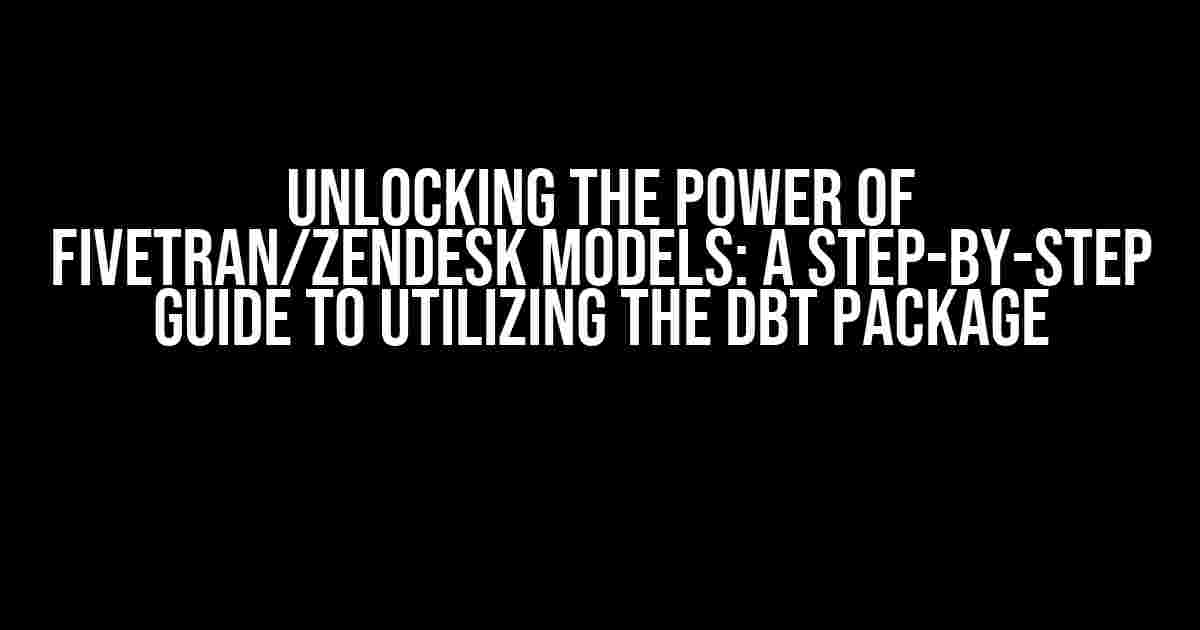Are you tired of struggling to make sense of your customer support data? Do you want to unlock the secrets of your Zendesk instance and gain valuable insights into your customers’ needs? Look no further! In this comprehensive guide, we’ll show you how to harness the power of Fivetran’s dbt package to tap into the rich data stored in your Zendesk database.
What is the Fivetran/Zendesk dbt Package?
The Fivetran/Zendesk dbt package is a powerful tool that allows you to harness the power of your Zendesk data. By leveraging dbt’s (Data Build Tool) ability to transform and model data, you can create a unified view of your customer support data, extract valuable insights, and make data-driven decisions. The package includes pre-built models and tables that enable you to easily access and analyze your Zendesk data.
Why Use the Fivetran/Zendesk dbt Package?
- Streamlined Data Analysis**: The package provides a single, unified view of your Zendesk data, making it easier to analyze and gain insights.
- Faster Data Integration**: Fivetran’s dbt package eliminates the need for manual data integration, saving you time and reducing the risk of errors.
- Improved Data Quality**: The package ensures data consistency and accuracy, providing a reliable foundation for data-driven decision-making.
- Enhanced Collaboration**: By providing a single source of truth for your Zendesk data, the package fosters collaboration and alignment across teams.
Getting Started with the Fivetran/Zendesk dbt Package
Before you can start utilizing the Fivetran/Zendesk dbt package, you’ll need to complete the following prerequisites:
- Fivetran Account**: Create a Fivetran account and set up a new connector for your Zendesk instance.
- dbt Installation**: Install dbt on your machine using the instructions provided on the dbt website.
- dbt Project Set-up**: Create a new dbt project and configure it to connect to your Fivetran account.
Step 1: Install the Fivetran/Zendesk dbt Package
dbt deps --package fivetran/zendesk
This command will install the Fivetran/Zendesk dbt package and its dependencies.
Step 2: Configure Your dbt Project
Update your `dbt_project.yml` file to include the Fivetran/Zendesk package:
models:
- fivetran_zendesk
This configuration tells dbt to include the Fivetran/Zendesk package in your project.
Step 3: Run dbt
dbt run
This command will execute the dbt models and create a series of tables in your target database.
Exploring the Fivetran/Zendesk dbt Package
The Fivetran/Zendesk dbt package includes a range of pre-built models and tables that enable you to easily access and analyze your Zendesk data. Let’s take a closer look at some of the key models and tables:
| Model/Table | Description |
|---|---|
| stg_zendesk_tickets | Houses raw ticket data from Zendesk |
| stg_zendesk_users | Houses raw user data from Zendesk |
| dim_tickets | Transformed ticket data, including ticket ID, subject, and status |
| dim_users | Transformed user data, including user ID, name, and email |
| fct_ticket_activity | Fact table containing aggregated ticket activity data, including ticket ID, created_at, and updated_at |
Utilizing the Fivetran/Zendesk Models in Your Analysis
Now that you have the Fivetran/Zendesk dbt package set up, it’s time to start analyzing your Zendesk data! Here are some examples of how you can utilize the pre-built models and tables:
Example 1: Analyzing Ticket Volume by Day
SELECT
date_trunc('day', created_at) AS date,
COUNT(*) AS num_tickets
FROM
dim_tickets
GROUP BY
1
ORDER BY
1
This query analyzes ticket volume by day, providing insights into when your support team is busiest.
Example 2: Identifying Top Support Agents by Resolution Rate
SELECT
u.name,
COUNT(DISTINCT t.ticket_id) AS num_tickets,
COUNT(DISTINCT CASE WHEN t.status = 'closed' THEN t.ticket_id END) AS num_resolved_tickets,
COUNT(DISTINCT CASE WHEN t.status = 'closed' THEN t.ticket_id END) / COUNT(DISTINCT t.ticket_id) * 100 AS resolution_rate
FROM
dim_users u
JOIN dim_tickets t ON u.user_id = t.assignee_id
WHERE
t.status = 'closed'
GROUP BY
1
ORDER BY
3 DESC
This query identifies top support agents by resolution rate, providing insights into who is most effective at resolving customer issues.
Conclusion
In this comprehensive guide, we’ve shown you how to harness the power of the Fivetran/Zendesk dbt package to unlock insights from your Zendesk data. By following the steps outlined in this article, you can start utilizing the pre-built models and tables to drive data-driven decision-making and improve your customer support operations.
Remember, the Fivetran/Zendesk dbt package is a powerful tool that can help you streamline data analysis, improve data quality, and enhance collaboration across teams. By leveraging its capabilities, you can unlock the full potential of your Zendesk data and drive business success.
Happy analyzing!
Frequently Asked Question
Got stuck trying to utilize the Fivetran/Zendesk models from its dbt_package? Don’t worry, we’ve got you covered! Here are some frequently asked questions to help you navigate this journey.
What do I need to do to utilize the Fivetran/Zendesk models?
To utilize the Fivetran/Zendesk models, you’ll need to install the dbt_package, which includes the pre-built models and transformations. You can do this by running `dbt deps` in your terminal, followed by `dbt install fivetran_zendesk`. This will install the package and its dependencies.
How do I configure the Fivetran/Zendesk models to connect to my Zendesk instance?
To configure the models to connect to your Zendesk instance, you’ll need to create a `fivetran_zendesk` block in your `dbt_project.yml` file. This block should include your Zendesk subdomain, username, and password. You can also specify other settings, such as the sync interval and data filtering, as needed.
Can I customize the Fivetran/Zendesk models to fit my specific business needs?
Yes, you can customize the Fivetran/Zendesk models to fit your specific business needs. dbt provides a flexibility to modify the models to accommodate your specific requirements. You can create custom models, aggregate tables, or add new columns to existing tables. The possibilities are endless!
How do I troubleshoot issues with the Fivetran/Zendesk models?
If you encounter issues with the Fivetran/Zendesk models, start by checking the dbt logs for errors. You can also try running `dbt debug` to get more information about the issue. Additionally, you can reach out to the Fivetran support team or the dbt community for help.
What kind of data can I expect to get from the Fivetran/Zendesk models?
The Fivetran/Zendesk models provide a wide range of data from your Zendesk instance, including ticket data, customer information, and agent activity. You can use this data to gain insights into your customer support operations, track trends, and optimize your support workflow.


